


The old barrelmaker’s shop that forms part of the outbuildings of the Benediktbeuern Monastery dates from the second half of the 18th century and is therefore a listed building. Its most remarkable features are its baroque hipped roof and distinctive king post construction. But when part of the wooden ceiling was removed to gain access to the attic, it was found that almost all of the beam ends were severely infested with wood-destroying fungi.
The Fraunhofer IBP researchers saw this as an opportunity to test different renovation methods and measurement techniques in a single building. They restored a total of 24 damaged beam ends, using six renovation methods that differed mainly in terms of the type of insulation, beam support brackets, and the hollow space in which the beam ends are inserted.
What is the best way to renovate wooden beam ends? Measurements of the renovated structure demonstrated that the moisture content in all beam ends lay in an uncritical range, and never exceeded 16 percent by mass during a whole year of testing. This seems to indicate that the composition of the beam supports – mortar, elastomers or nanogel – is a relatively insignificant factor, as are the insulation and the air gap. In other words, no clear conclusion could be drawn about the best renovation method from the moisture content. Although it was observed that beam ends with a copper cap serving as a thermal bridge demonstrated the highest surface temperatures, this did not result in lower moisture values compared with other wooden beam ends. Inhomogeneities in the structure of the wall appear to play a greater role than the choice of renovation method. To verify this hypothesis, the researchers calculated the moisture curve for three renovation methods using the WUFI® 2D simulation program. The factors that entered into this calculation were changes in the outdoor climate measured using local environment sensors, and measurements of the indoor climate. These calculations confirmed the results of the sensor measurements, i.e. the choice of renovation method is insignificant.
The tests proved that the choice of mechanisms to support the beam ends in the masonry are much less critical than expected. The damage repeatedly observed in beam ends is more likely to be a result of unexpected incidents occurring many years after the building was constructed, such as the displacement of roof tiles, blocked gutters or other sources of leaks. Consequently, few errors can be made when replacing or repairing damaged beam ends, as long as their outer surface is sufficiently protected against rain.